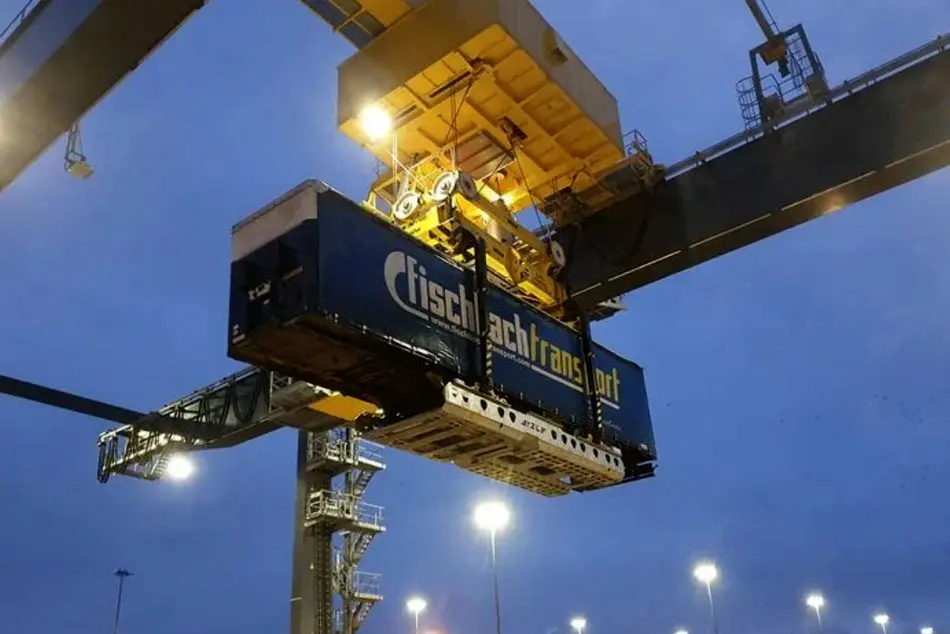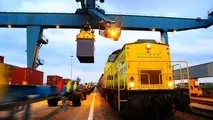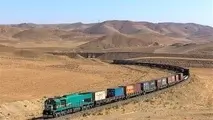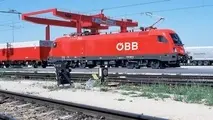Non-cranable trailers also on train from Port of Rotterdam
It is now possible to load non-cranable trailers on the train from the port of Rotterdam. This is thanks to the VEGA-VTG plates, which are available at the C.RO Ports terminal in the Botlek. This vertical loading technology lifts non-cranable trailers on the train between the United Kingdom and the Polish city Rzepin.

It is now possible to load non-cranable trailers on the train from the port of Rotterdam. This is thanks to the VEGA-VTG plates, which are available at the C.RO Ports terminal in the Botlek. This vertical loading technology lifts non-cranable trailers on the train between the United Kingdom and the Polish city Rzepin.
For the time being, it concerns five units that are available three times a week on the UK-Poland route However, this capacity could be doubled soon, says Thomas Derks, agent for the product in the Benelix. “There is certainly interest from the market. Thanks to this platform, rail suddenly becomes an option for parties which normally cannot use rail.”
Second in the Netherlands
Non-cranable trailers are traditionally transported by truck in Europe, due to a lack of facilities to lift these units on a train. In the last few years, however, the rail freight market has realised the untapped market of around a million existing non-cranable trailers. Several techniques have popped up. The VEGA-VTG solution seems. to have conquered the Netherlands. In June last year, GVT Intermodal successfully deployed sixteen units to be placed in Tilburg, in the south of the Netherlands. Also here, the units are used on the route to Rzepin, and back.
The VEGA-VTG solution is a vertical loading technique. The concept relies on a basket, which is placed on the ground in the terminal. The truck rides over the basket and drops the trailer once it is in the right position. The truck then leaves and the basket is lifted on the wagon, for which it is a perfect fit.
Major impact
“A good example of an apparently simple innovation with a major impact”, adds Matthijs van Doorn, Logistics Manager at the Port of Rotterdam Authority. “It is reported that 80 per cent of the trailers cannot be craned and this solution opens the door to transport by rail for those trailers. With this we are taking extra steps to further shape the sustainability objectives by means of the modal shift towards rail freight transport. ”
In addition to the C.RO terminal, there is a good chance that the platforms will also be available at the Rail Service Center Rotterdam. Derks: “There, it would be for the loading of tank trailers, the technology is also suitable for those units.” The fourth place in the Netherlands where the innovation will be deployed is most likely Venlo, where the Cabooter Group intends to start using it in the course of this spring.
Other techniques
The technique, developed by manufacturer Vega, is comparable to other vertical loading concepts such as that of NiKRASA. This has been employed by TX Logistik, and is successfully lifting non-cranable trailers on trains running between Hungary and Germany. The main difference is that this technique relies on a platform that remains at the terminal, and a platform that stays with the trailer on the train.
Other than the vertical techniques, there is horizontal loading. An example is the Lohr System, where the trailer is pushed onto a platform in a horizontal movement. This concept is in place in the CLIP terminal in Poznan, for transport on the connection between this Polish city and Bettembourg Dudelange in Luxembourg.
Positioning
When it comes to the concept of Vega, there are certain challenges as well. It takes a bit of manoeuvring to place the trailer in the right position on the basket, Marc Hunziker from VTG explained in RailFreight Live when the system was deployed in Tilburg. “This manouvring takes practice, but we are also working on a laser system which will send a signal to the truck cabin when the truck is in the right position.”
“What is most important, is that we contribute to the shift of non-cranable trailers to rail”, he said at that time. “We want to complement the existing systems and add another concept to the market. Rail transportation is a sustainable transportation mode. If we can shift around 50,000 non-cranable trailers from road to rail in the next two to three years, we are very happy.”



